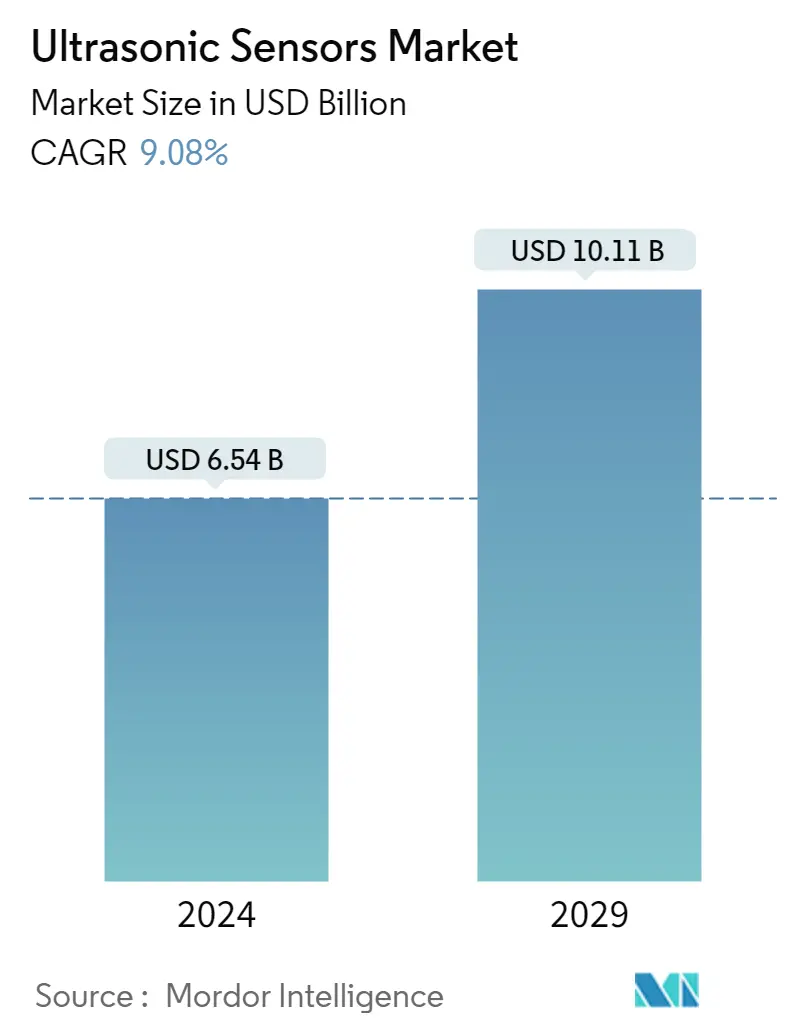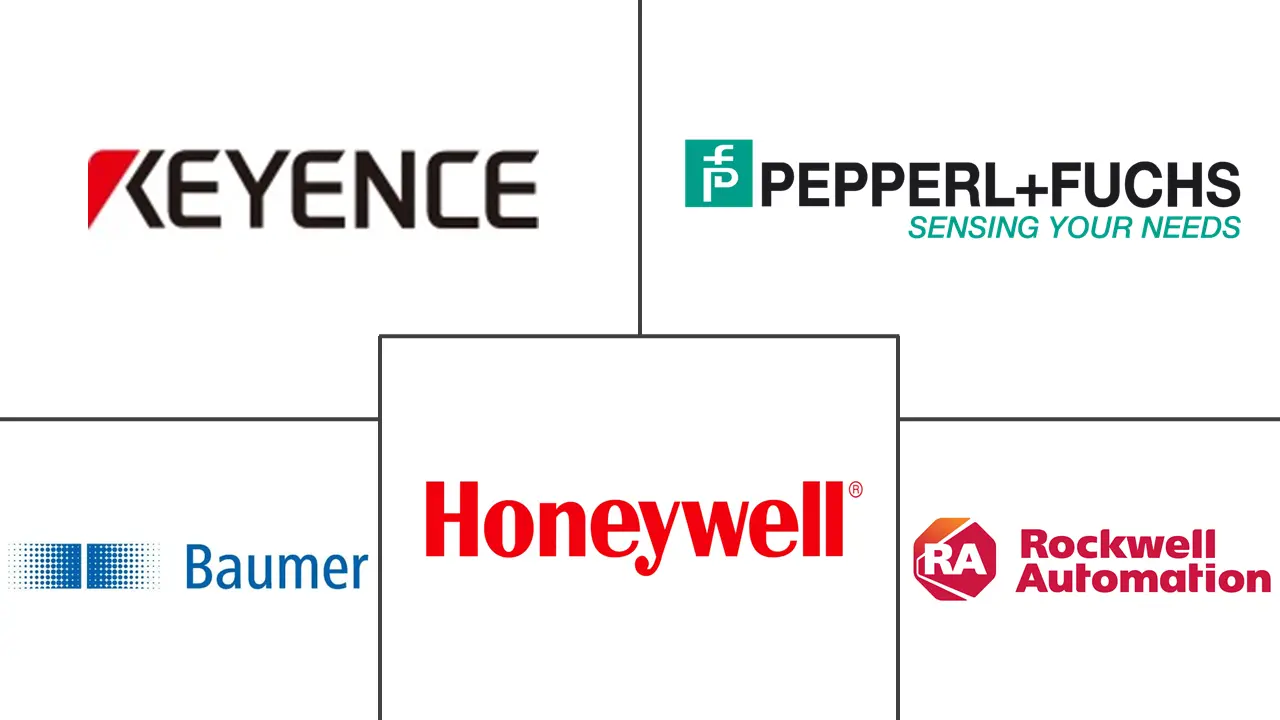Market Size of Ultrasonic Sensors Industry

| Study Period | 2019 - 2029 |
| Market Size (2024) | USD 6.54 Billion |
| Market Size (2029) | USD 10.11 Billion |
| CAGR (2024 - 2029) | 9.08 % |
| Fastest Growing Market | Asia-Pacific |
| Largest Market | North America |
| Market Concentration | Low |
Major Players
*Disclaimer: Major Players sorted in no particular order |
Ultrasonic Sensors Market Analysis
The Ultrasonic Sensors Market size is estimated at USD 6.54 billion in 2024, and is expected to reach USD 10.11 billion by 2029, growing at a CAGR of 9.08% during the forecast period (2024-2029).
- Ultrasonic sensors are widely utilized for non-contact detection of solid and liquid state objects. These sensors operate at frequencies higher than 20 kHz, above the sonic range audible to humans. Widely used in robots, autonomous guided vehicles, and drones, ultrasonic sensors are common in a range of applications. Ultrasonic sensors provide relatively precise measurements, with errors usually within 1%. They can make many measurements per second, yielding quick refresh rates. Additionally, they are usually quite cheap because they do not need rare materials.
- The growth of the market studied is positive and is anticipated to grow enormously due to the emergence of enhanced applications in high-growth sectors like automotive, healthcare, and machine handling, along with the fingerprint-based application that is gaining momentum in consumer products. These sensors deliver better price performance than other sensors by relying on economies of scale advantages.
- Owing to their real-time visualization ability, sensors can also be used for tissue biopsy sampling or therapeutics while locating target organs. These sensors are also used to diagnose internal organs, including the kidneys, liver, pancreas, and gallbladder, or to observe pregnant women's fetal growth and health condition.
- Automotive functions like cruise control, driver assistance, and anti-theft systems use ultrasonic sensors. Additionally, they are also being used in various applications for distance measurement in the material handling sectors. Ultrasonic sensor manufacturers have offered multiple variants of ultrasonic sensors with additional capabilities like open structures, waterproofing, and external casing to reduce damage. Thus, ultrasonic sensors will also witness a proportional rise with the expected increase in ADAS systems.
- The market is witnessing product developments and research. For instance, in Nov 2022, Ultraleap developed a new ultrasonic sensor and transducer for virtual reality systems for the metaverse and touchless controllers in vehicles. Such initiatives by various companies and organizations are expected to contribute to the increase in the demand for ultrasonic sensors in the market.
- However, the limited detection range of the ultrasonic sensors could restrict their effectiveness in certain applications where a wider range of detection is required. They may also have certain technological limitations, like susceptibility to interface from environmental factors like temperature, humidity, etc. These limitations can affect the reliability and accuracy of the sensor readings.
- Further, ultrasonic sensors can be relatively expensive compared to other types of sensors. This cost factor might be a restraint for some businesses or industries, especially when large-scale deployment of sensors is required.
Ultrasonic Sensors Industry Segmentation
The basic working principle of ultrasonic sensors is based on echolocation, involving the transmission of ultrasonic waves to the target object, which reflects it to the source after receiving the initial wave. Ultrasonic sensors detect the object's exact position by calculating the distance from the source's "echo" generated by the object.
The scope of the report includes the different technologies used in ultrasonic sensors, such as Bulk Piezoelectric Transducers and Micromachined Ultrasound Transducer, and their applications in various end-user verticals. The study also tracks the key market parameters, underlying growth influencers, and major vendors operating in the industry, which supports the market estimations and growth rates over the forecast period. The study further analyzes the overall impact of key macroeconomic trends on the ecosystem. The scope of the report encompasses market sizing and forecast for segmentation by technology, end-user vertical, and geography. The market sizes and forecasts are provided in terms of value (USD) for all the above segments.
| By Technology | |
| Bulk Piezoelectric Transducer | |
| Micromachined Ultrasound Transducers (MUT) |
| By End-user Vertical | |
| Automotive | |
| Consumer | |
| Industrial | |
| Medical | |
| Other End-user Verticals |
| By Geography*** | |||||
| |||||
| |||||
| |||||
| Latin America | |||||
| Middle East and Africa |
Ultrasonic Sensors Market Size Summary
The ultrasonic sensors market is poised for significant growth, driven by their extensive application across various industries such as automotive, healthcare, and manufacturing. These sensors, operating at frequencies above the audible range for humans, are integral to non-contact detection and measurement tasks, offering high precision and rapid data acquisition. Their cost-effectiveness, due to the absence of rare materials, and their ability to deliver superior price performance through economies of scale, make them a preferred choice in sectors like automotive for applications such as parking assistance, collision avoidance, and driver assistance systems. The market is also witnessing innovations, with companies developing advanced sensors for emerging technologies like virtual reality and touchless vehicle controls, further propelling demand.
Regionally, the Asia-Pacific area stands out as a major hub for ultrasonic sensor manufacturing and consumption, with countries like China, Japan, and India playing pivotal roles. China's initiatives in smart manufacturing and digital infrastructure, along with Japan's focus on autonomous vehicles, are expected to bolster market growth. India's 'Make in India' program further enhances the region's manufacturing capabilities, contributing to the market's expansion. The competitive landscape is marked by key players such as Siemens AG, Honeywell International Inc., and Rockwell Automation, who are actively engaging in research and product innovation to maintain their market positions. Despite challenges like limited detection range and environmental susceptibility, the market's trajectory remains positive, supported by ongoing technological advancements and increasing adoption across various sectors.
Ultrasonic Sensors Market Size - Table of Contents
-
1. MARKET INSIGHTS
-
1.1 Market Overview
-
1.2 Industry Attractiveness - Porter's Five Forces Analysis
-
1.2.1 Bargaining Power of Buyers
-
1.2.2 Bargaining Power of Suppliers
-
1.2.3 Threat of New Entrants
-
1.2.4 Threat of Substitutes
-
1.2.5 Intensity of Competitive Rivalry
-
-
1.3 Industry Value Chain Analysis
-
1.4 An Assessment of the Impact of Key Macroeconomic Trends
-
-
2. Market SEGMENTATION
-
2.1 By Technology
-
2.1.1 Bulk Piezoelectric Transducer
-
2.1.2 Micromachined Ultrasound Transducers (MUT)
-
-
2.2 By End-user Vertical
-
2.2.1 Automotive
-
2.2.2 Consumer
-
2.2.3 Industrial
-
2.2.4 Medical
-
2.2.5 Other End-user Verticals
-
-
2.3 By Geography***
-
2.3.1 North America
-
2.3.1.1 United States
-
2.3.1.2 Canada
-
-
2.3.2 Europe
-
2.3.2.1 United Kingdom
-
2.3.2.2 Germany
-
2.3.2.3 France
-
-
2.3.3 Asia
-
2.3.3.1 China
-
2.3.3.2 Japan
-
2.3.3.3 India
-
-
2.3.4 Latin America
-
2.3.5 Middle East and Africa
-
-
Ultrasonic Sensors Market Size FAQs
How big is the Ultrasonic Sensors Market?
The Ultrasonic Sensors Market size is expected to reach USD 6.54 billion in 2024 and grow at a CAGR of 9.08% to reach USD 10.11 billion by 2029.
What is the current Ultrasonic Sensors Market size?
In 2024, the Ultrasonic Sensors Market size is expected to reach USD 6.54 billion.

